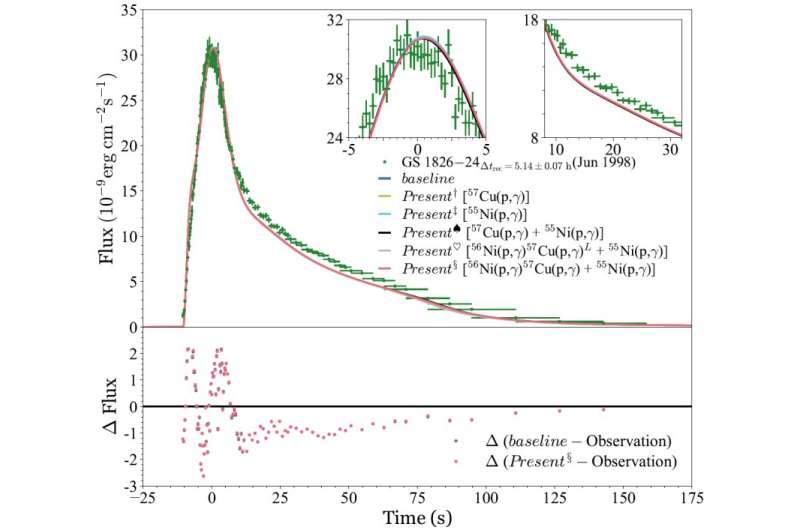New proton capture reaction rate of copper-57 changes nucleosynthesis paths in Type-I X-ray burst

An international research team has recently developed a new proton capture reaction rate of copper-57 for the extreme astrophysical environment at the surface of neutron stars. The researchers found that the new reaction rate changes some of the most critical nucleosynthesis paths in Type-I X-ray bursts.
Published in The Astrophysical Journal, the study was conducted by researchers at the Institute of Modern Physics of the Chinese Academy of Sciences, Monash University, the Centre d’Etudes Nucléaires de Bordeaux-Gradignan, the Joint-Institute for Nuclear Astrophysics, and RIKEN.
Since the first Type-I X-ray burst was discovered in the last century, astrophysicists have been keen to understand the physics driving these bursts. This includes understanding their energy generation, the composition of burst ashes left on the neutron star surface, and perhaps even their contribution to the formation of some of the rarest chemical elements in the universe.
To build accurate models of these bursts, in addition to the macroscopic astrophysical conditions, scientists need to accurately know the nuclear reaction rates of the key nuclides. The detailed knowledge of the nuclear reaction path permits them to model the syntheses of the chemical elements.
Previous studies indicate that the proton capture reaction of copper-57 is the fifth most influential reaction affecting the periodic thermonuclear burst of the X-ray source GS 1826-24.
In this study, the research team obtained the new proton capture reaction rate of copper-57, which is as low as only 20% of the previous rate. Using a state-of-the-art Type-I X-ray burst simulation model (KEPLER code), they successfully reproduced a set of theoretical X-ray burst light curves that closely match the observed light curves of GS 1826-24 X-ray source.
They found that the new proton capture reaction rate of copper-57 significantly changes the burst ash composition. The burst ash composition is an essential ingredient to the studies of superbursts that burn these ashes and of neutron star cooling.
These results help to better constrain the equation of state of nuclear matter under extreme conditions inside neutron stars, which is a key ingredient for understanding gravitational waves from binary neutron star mergers and gamma-ray burst counterparts in the era of multi-messenger astronomy.
New proton capture rate of arsenic-65 changes periodic thermonuclear X-ray bursts
Yi Hua Lam et al, The Regulated NiCu Cycles with the New 57Cu(p,γ)58Zn Reaction Rate and Its Influence on Type I X-Ray Bursts: the GS 1826–24 Clocked Burster, The Astrophysical Journal (2022). DOI: 10.3847/1538-4357/ac4d89
Citation:
New proton capture reaction rate of copper-57 changes nucleosynthesis paths in Type-I X-ray burst (2022, June 17)
retrieved 17 June 2022
from https://phys.org/news/2022-06-proton-capture-reaction-copper-nucleosynthesis.html
This document is subject to copyright. Apart from any fair dealing for the purpose of private study or research, no
part may be reproduced without the written permission. The content is provided for information purposes only.
For all the latest Science News Click Here
For the latest news and updates, follow us on Google News.

